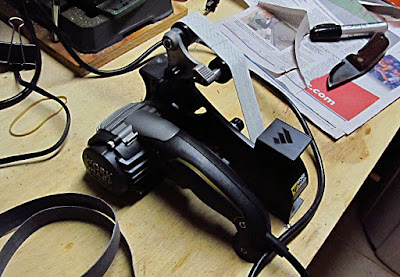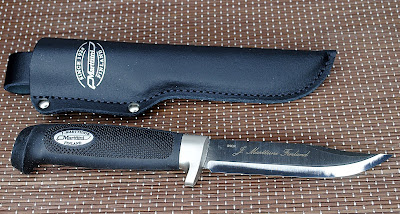Do you say ‘switchblade’ or ‘automatic
knife’?
Sounds like a George Carlin
question. Switchblade is warm and
fuzzy. Automatic is hard and cold.
To me, this is what I consider a switchblade. It’s a classic Italian stiletto. It clicks open with a menacing double click.
 |
A classic switchblade what would be carried by the Jets or the Sharks.
|
This is not an expensive one; I couldn’t find a maker’s
mark. The blade is stamped “rust free”
so I assume it’s stainless steel and is too dull to even cleanly open
envelopes. I remember when knives came
relatively dull and you put the kind of edge you wanted. But I don’t want to sharpen it and alter the
‘factory edge’. It has the classic
release button which allows a leaf spring to fire the knife open, a slide safety
and a horn handle. I got it as part of an
estate I purchased and kept it because the knife was unlocked by depressing a
tab on the knife’s butt.
But say automatic to me and I got to go with Pro-Tech
knives.
Pro-Tech Knives, LLC is a family knife company owned and
founded by Dave Wattenberg. They have
been building high quality American Made knives since 1998.
Pro-Tech produces about 12,000 knives per year and its most
famous models are the Godfather, Godson, and the Runt J4. You’ll see Pro-Techs in the hands of the U.S.
Military and law enforcement including the Secret Service and US Marshall's
Service. You’ll also see them in the
hands of collectors and anyone demanding high performance from an automatic
knife.
(Hint: Get yourself a
collaboration between Pro-Tech and Boker.
It’s a sweet little auto. You will not be disappointed!)
I’ve always wanted a Godfather. Not any of the variations. I wanted the Tuxedo. For years I watched the one with an actual
Ivory insert. But then, when we were
still relatively ivory friendly, it was out of my price range. But the ivory micarta, that was just too
powerful of a call. I went with the
black blade to compliment the black and white motif. I can’t help but think of Dino, Sammy, Frankie
and the rest of the Las Vegas rat pack when I see it open.
 |
Pro Tech 's Godfather It's pissy eligant!
|
It’s a big knife.
Take it down a step and you’ll see the Godson and I found one I liked.
Same good lines but I went with Bruce Shaw’s Steampunk copper insert.
Steampunk? It is a
visited reality in which Jules Verne’s world still exists. It just matured a little and discovered sexy.
 |
| If you needed to cut the mooring line a dirigible and escape in your velociped, this is the knife you need |
Shaw received his art training at Cal-State University at
Los Angeles and graduated as a mechanical engineer, and what could be a better
background for Steampunk? He started
engraving in 1978 and has been engraving full time since 1984. The copper plate features engravings of gears
and mechanisms of a mechanical watch some of which drive one of his classic
skulls. It was a limited edition and I
was just lucky enough to be in the right place.
If you think of the Godfather and Godson as part of a family
of knives, then the limited production of their Rockeye Auto PK custom has to
be the hippy uncle from the LSD 70s.
 |
Dude, it's time for the Airplane on next! They follow Cream.
|
The Rockeye line was designed by Les George. Les started making knives in 1992 and found a
kindred soul in master builder Stan Fujisaka of Kaneohe, Hawaii to show him the
ropes. Sadly, Stan passed away on New Year’s
Eve just a few hours before the arrival of the new 2014. One has to wonder what kind of knife shows
they must have in the afterlife.
Having served in the Marines with a wide variety of jobs,
Les has developed well-defined ideas about what how knives and tools should be
made for use. You can see this in the
strong blade and handle of the Rockeye line.
The handle was anodized by Peter Kellett, who may be best
known for his unique, one of a kind art of amazing designs of metal guitars and
Pro-Tech knives. I was told, but can’t confirm,
that only four, maybe eight of these knives were made and again I was at the
right place.
If you had a cousin knife from the Deep South, maybe New
Orleans or the swamps of Florida, it would be the TR-3 Alligator. The Tactical Response 3 is a favorite with law
enforcement and military. They are hardworking
knives with a 3.5 inch blade, an automatic knife that is slender and fits
nicely in the pocket. But I can almost
guarantee none of them are carrying the TR-3 purple alligator. Artist Peter Kellett returns to marry a
purple alligator and a mother of pearl release button to a tactical knife.
 |
| I hear to tell chicken taste like gator. Where can I get me some? |
I like the style of Pro-Tech knives. I especially like their custom or ‘arty
knives’. You can go to their website (http://www.protechknives.com/product-category/automatic/)
and find some amazing knives. How about
a left-handled Godson in basic black?





































